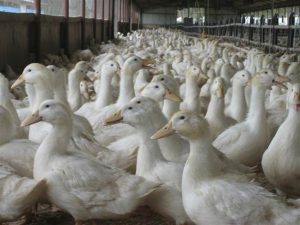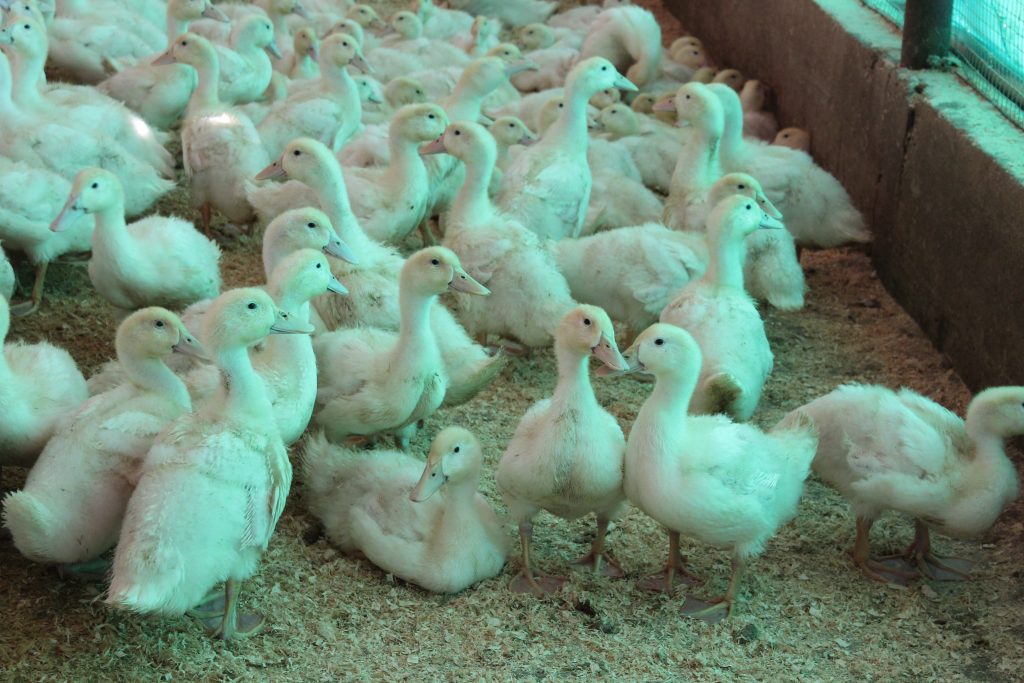Nutrient requirements of ducks
Nutrient requirements of ducks
Unfortunately, very little research has been done in Australia on the nutritional requirements of ducks. Nearly all the information comes from overseas sources. However, the basic principles of poultry nutrition must be applied to ducks if the best results are to be obtained from both breeding and growing stock.
The use of antibiotics appears to be unwarranted, and some antibiotics and 3-nitrophenylarsonic acid (a growth promoter) can be toxic. Ducklings should be started on a diet containing 20% protein within 36 hours of hatching. Maintain this protein level for 2 weeks and then reduce it to 17% until marketing. Higher protein rations may be used if faster growth is required. As high-energy rations tend to cause too much fat to be deposited, they are not recommended.
Both riboflavin and niacin must be added to the diet because deficiencies of these B group vitamins restrict growth and development in ducklings. Grains, which form the bulk of the ration, are deficient in these vitamins. Salt generally makes droppings more watery and should not be added to rations. One-quarter per cent (0.25%) of common salt is not harmful, but ducklings up to the age of 3 weeks are very sensitive to salt. Give ducklings free access to feed crumbles and give them starter feed (in shallow trays) up until they are 2 weeks of age.

Table 1. Minimum basic nutritional requirements of ducklings
| Nutrient | Starter | Grower | Breeder |
| Protein (%) | 20-22 | 17-19 | 16 |
| Calcium (%) | 1 | 1 | 3 |
| Fat (%) | 5 | 5 | 5 |
| Methionine + Cysteine(%) | 0.76 | 0.77 | 0.80 |
| Lysine | 1.16 | 0.90 | 0.94 |
| Arginine | 0.94 | 1.0 | 0.60 |
| Threonine | 0.84 | 0.66 | 0.60 |
| Phosphorus (%) | 0.40 | 0.35 | 0.40 |
| Manganese (mg/kg) | 60 | 50 | 40 |
| Niacin (mg/kg) | 55 | 40 | 55 |
| Pantothenic acid (mg/kg) | 15 | 10 | 20 |
| Pyridoxine (mg/kg) | 3 | 3 | 3 |
| Riboflavin (mg/kg) | 10 | 6 | 10 |
| Vitamin A (mg/kg) | 3100 | 1720 | 4130 |
| Vitamin D3 (mg/kg) | 300 | 22.5 | 62.5 |
| Vitamin K (mg/kg) | 2.5 | 2 | 2.5 |
| Energy (kcal/kg) | 2900 | 3000 | 2750 |
Rations for growing ducks
If mash is fed to the ducklings, moisten it slightly with water. (Table 2 gives ration mixtures.) Give five equally spaced feedings throughout the day and make sure they do not have more than they can eat at one feeding.
Cheap food, such as stale bread and kitchen refuse, can greatly reduce feeding costs when used in the ration correctly. These substitute ingredients should be fed only to ducklings that are over the age of 2 weeks. Kitchen refuse should be boiled to kill any harmful bacteria and to make the feed more palatable before it is fed to ducklings. After boiling, thoroughly mix the refuse with the mash. Because the quality and type of food from kitchen refuse varies tremendously, no general recommendations can be made for proportions of refuse to mash.
Bread has a protein content of about 9%, and can be used to provide up to 40% of the total ingredients. Use it to replace equal amounts of crushed grain, but adjust so the reduced protein and amino acid content are increased.
Ducklings should have access to insoluble grit, and to plenty of fresh drinking water in a container that enables immersion of the head.
Table 2. Rations for growing ducks*
| Ingredients | Day-old to marketing | |
| Ration 1 (%) | Ration 2 (%) | |
| Crushed grain | 46 | 19 |
| Bread | – | 40 |
| Bran | 18 | 10 |
| Pollard | 18 | 10 |
| Meatmeal | 10 | 11 |
| Soybean meal | 3 | 3 |
| Lucerne meal | 3 | 4 |
| Milk powder | 2 | 3 |
| Ground limestone | – | – |
| Total | 100 | 100 |
*A vitamin and mineral premix should be added to the rations in Table 2.
Rations for breeding stock
Rations for breeding hens are usually adequate for breeding ducks. Rear potential breeding stock on a similar diet to that given to ducklings raised for meat consumption. When ducklings are about 8 weeks of age, transfer them to a breeder’s ration. Breeding ducks should then be restrictively fed to about 80% of their normal daily feed intake until 2 weeks before the onset of egg production. This will prevent the ducks from becoming over-fat.
Breeding stock require the basic nutritional levels given in Table 1. The same rules apply to feeding both meat ducklings and breeding stock. Ducks can be fed on both mash and pelleted feed, but crumbles and pellets are more economical because less feed is wasted and weight gains are higher. Also, mash tends to stick to ducks’ bills, causing some birds to choke. Crumbles or pellets can be placed in hoppers so ducks have access to them at all times, or wet mash may be fed twice daily. Each duck will eat about 225 g of feed per day. Provide about 40% of this in the morning feed and 60% in the evening feed. Ducks must have access to unlimited soluble grit, such as shell grit, and to unlimited fresh drinking water.
Table 3. Rations for breeding ducks*
| Ingredients | Breeders | |
| Ration 1 (%) | Ration 2 (%) | |
| Crushed grain | 39 | 20 |
| Bread | – | 40 |
| Bran | 18 | 10 |
| Pollard | 25 | 10 |
| Meatmeal | 6 | 8 |
| Soybean meal | – | – |
| Lucerne meal | 5 | 5 |
| Milk powder | 5 | 5 |
| Ground limestone | 2 | 2 |
| Total | 100 | 100 |
*A vitamin and mineral premix should be added to the rations in Table 3.
Feed consumption

Table 4 serves only as a guide to expected feed consumption. The actual amount of feed eaten will depend upon factors such as quality of feed, strain of ducks and method of management.
Table 4. Average feed consumption of Pekin ducks (mixed sexes)
| Age (weeks) | Feed for week (kg) | Cumulative feed (kg) |
| 0-1 | 0.15 | 0.15 |
| 1 | 0.40 | 0.55 |
| 2 | 0.75 | 1.30 |
| 3 | 0.95 | 2.25 |
| 4 | 1.00 | 3.25 |
| 5 | 1.30 | 4.55 |
| 6 | 1.65 | 6.20 |
| 7 | 1.80 | 8.00 |
| 8 | 1.60 | 9.60 |
Feed conversion ratios
In Australia, feed conversion ratios for ducks are a long way behind those obtained in the USA and the UK. Some overseas strains of ducks have feed conversion ratios around 2.5:1 when ducklings are marketed at 6 weeks of age with a live weight of nearly 3 kg. In Australia, it is usual to market ducks at an older age, and with lower body weight, for a feed conversion ratio of approximately 3:1. Ducks housed in controlled environment houses will have a much better feed conversion than those housed in conventional sheds.
Information provided by NSW Department of Primary Industries, Australia

